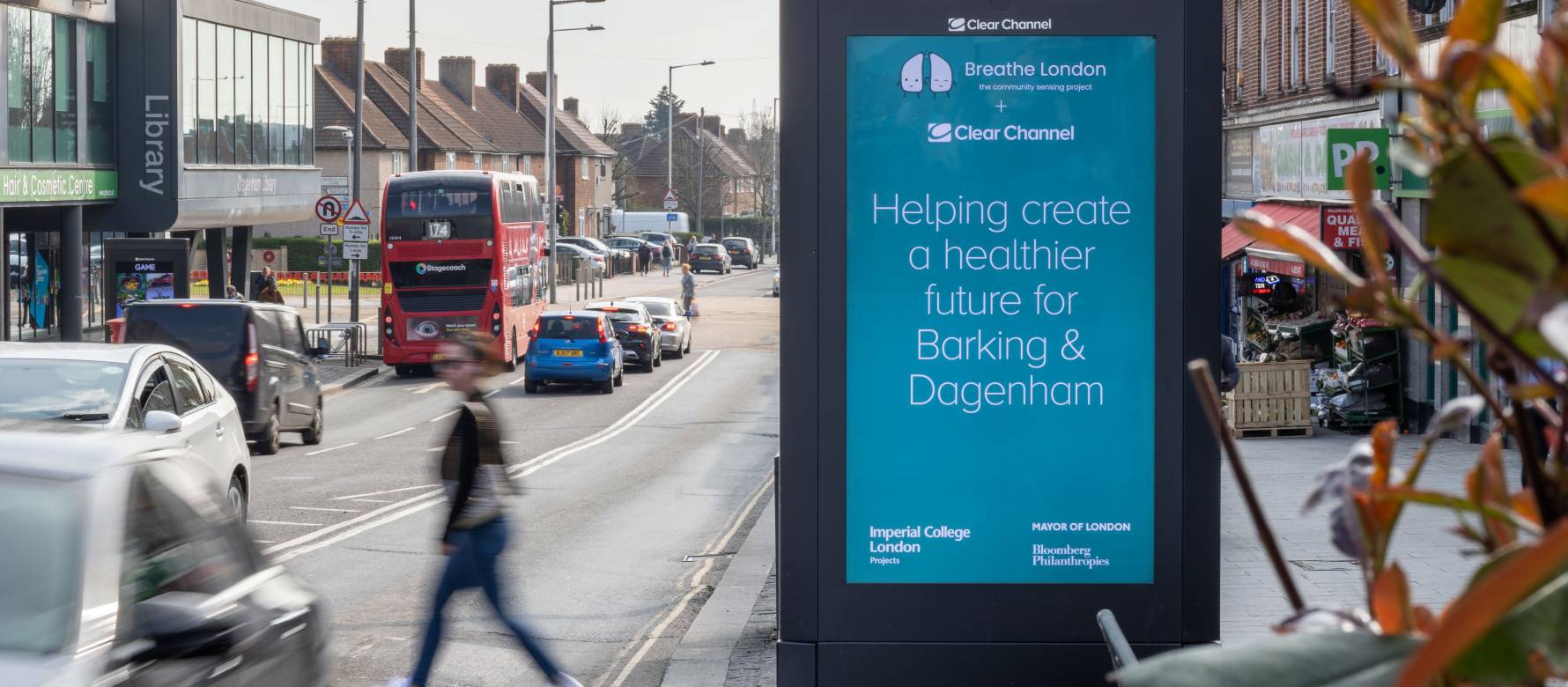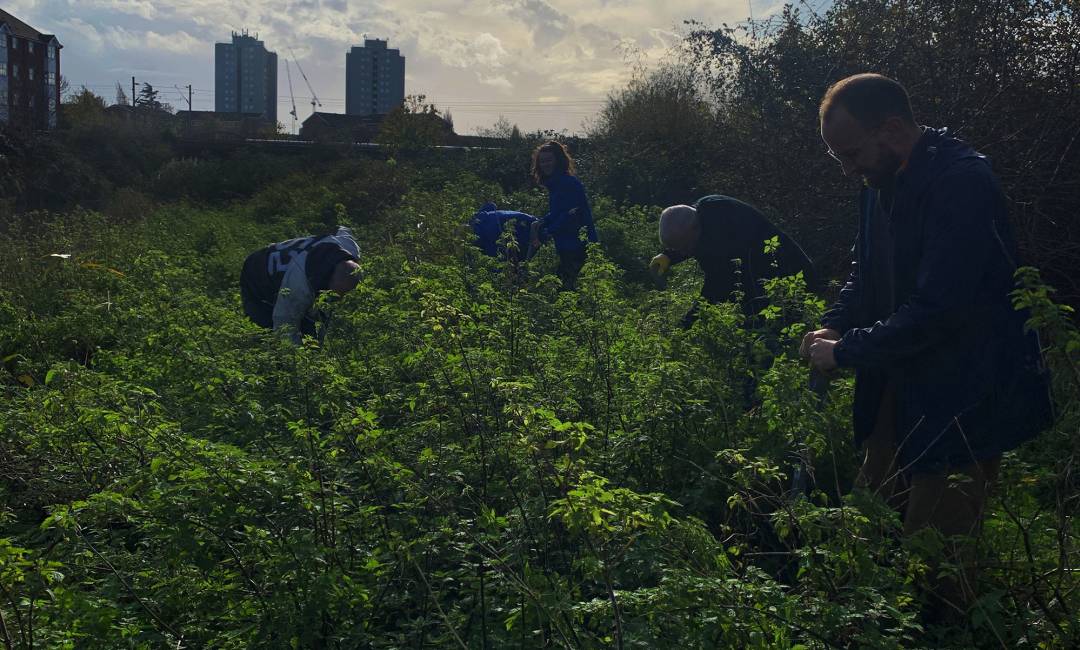Digital screens help monitor London’s air quality
25 Mar 2022 / News, Sustainability
Clear Channel and experts from Imperial College London have joined forces for a first-of-its-kind pilot, integrating air quality sensors into digital advertising displays in Barking & Dagenham.
Leading Out of Home media and infrastructure Company Clear Channel has partnered with the Environmental Research Group (ERG) at Imperial, to pilot a new initiative where Breathe London air quality sensors are integrated into digital advertising displays in Barking and Dagenham.
The Breathe London network is a new initiative developed by the ERG, funded by the Mayor of London and Bloomberg Philanthropies, to provide real-time, hyperlocal air quality data to Londoners, via the Breathe London website.
Clear Channel’s Product Development team, working closely with the team from Imperial, sensor manufacturer Clarity Movement and digital display partner Amscreen, have created a scalable, standardised solution to allow quick and easy rollout of air quality sensors across its national network of digital advertising displays.
The three pilot displays in Barking & Dagenham - specifically chosen for their high-footfall, where air pollution is most likely to be impacting the public – are now monitoring levels of nitrogen dioxide and particulate matter (PM2.5), known for their negative impact on respiratory health.
-1648217242.png)
Neil Chapman, Clear Channel’s Product Development Director
says, “Out of Home advertising most often exists in densely populated areas, where
air quality data is needed most and can bring most benefit to the public.”
“This pilot demonstrates how easy and affordable it can be for local authorities and existing air quality networks to use our street furniture to measure the air pollution in problem areas, and inform the right interventions to improve local air quality.”
Data from the sites in Barking and Dagenham is being transmitted to Breathe London, which also collects data from around 300 similar small sensors across London.
Unique analysis is conducted by the scientists at Imperial, combining Breathe London and reference grade monitor data, ensuring accurate information on air quality for Londoners.
Senior Air Quality Analyst Andrew Grieve, one of the scientists monitoring and analysing the data through Imperial Projects, says, “Air pollution is the biggest environmental risk to health in the UK and globally. The World Health Organisation recently updated their guidelines, setting much lower targets, showing we have further to go to protect public health.
“Only by monitoring air quality can we see if we are heading in the right direction, so we are hugely excited by this unique partnership between business, academia and local government to expand the Breathe London network.”
Data collected from the new sensors will be used by council officers at London Borough of Barking and Dagenham to improve their understanding of air pollution within the borough and monitor changes.
Councillor Margaret Mullane, Cabinet Member for Enforcement and Community Safety said, "We're determined to improve the quality of air in Barking and Dagenham to ensure our residents are living in a healthy environment. Launching our Air Quality Action Plan, to planting thousands of new trees in the borough to encouraging residents to turn their engines off when stationary are just some of the ways we're trying to do this.
"I am pleased to see that we're also introducing further air quality sensors, so we can really understand the issue in hot spot areas and work out what else needs to be done."
Data from the three sensors can be found on the Breathe London website: High Road (RM6 6PB), Station Parade (RM9 5BG) and Wood Lane (RM8 3NT).
About Breathe London
Breathe London aims to create a comprehensive and scalable air quality sensor network and easy access to real-time, hyperlocal air quality data. The sensor network, data analysis and website are managed by researchers from the Environmental Research Group at Imperial College London, through Imperial Projects. Funded by the Mayor of London and Bloomberg Philanthropies, Breathe London works with partners to raise awareness of air pollution and provide a better understanding of its impact on public health – as well as providing Londoners with access to free, and reliable, air quality data.
About Imperial College London and the Environmental Research Group
Imperial College London is one of the world's leading universities. The College's 20,000 students and 8,000 staff are working to solve the biggest challenges in science, medicine, engineering and business. Imperial is University of the Year 2022 in the Times and Sunday Times Good University Guide. It is the world’s fifth most international university, according to Times Higher Education, with academic ties to more than 150 countries. Reuters named the College as the UK's most innovative university because of its exceptional entrepreneurial culture and ties to industry.
The Environmental Research Group is part of Imperial’s School of Public Health and is a leading provider of air quality information and research in the UK, combining air pollution science, toxicology and epidemiology to determine the impacts of air pollution on health and the role specific pollutants play in causing disease and deaths.
They work closely with those responsible for air quality management supporting policies and actions to minimise the impact of air pollution on health and established the London Air Quality Network - and Breathe London Programme - which continuously monitors air pollution levels at sites across London. Imperial College London: Environmental Research Group
SHARE POST
PRESS ENQUIRIES




